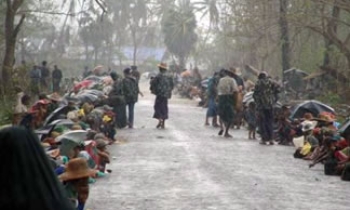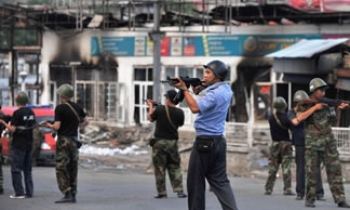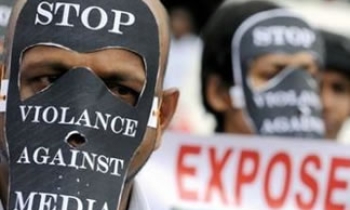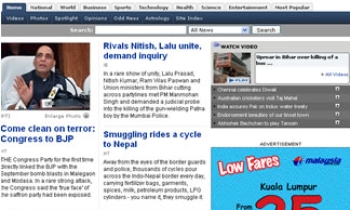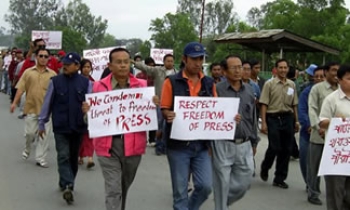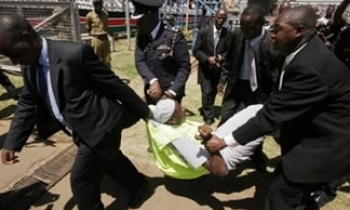MEXICO CITY: A month ago, the death of Bradley Will seemed cut and dried. The independent New York City journalist was shot in the chest while videotaping a lopsided confrontation between gunmen who supported the beleaguered governor of Oaxaca and protesters demanding his ouster.
Pictures of some of the gunmen, with their names, had appeared on the front pages of all the major papers. The two fatal bullets had come from a 9-millimeter pistol like those issued to the police. The case seemed a prosecutor's dream.
That is, until Dec. 1, when a judge freed two of the men photographed with guns shooting at the protesters, citing a lack of evidence. The ruling provoked accusations from leftists of a cover-up. The state's investigation into the killing of Will, as well as the deaths of a dozen protesters in the conflict, has drawn so much criticism that the federal police raided the state police headquarters on Friday and seized weapons to determine if any had been used in shootings during demonstrations.
Besides underscoring how infrequently killings of journalists and antigovernment protesters are solved in Mexico, the case has drawn widespread attention because it reveals the sad clash of leftist idealism, personified in Will, a bearded 36-year-old originally from Illinois, with the murky realities of Mexican politics.
Politics often warps investigations in Mexico, and Will's death in late October has quickly become a contentious issue in the very struggle he had come to document.
The protesters with whom Will was sympathetic say he was killed by government-backed paramilitary thugs who had already killed a dozen others since the conflict began in May. They charge that his death is still more proof the state government remains repressive, its prosecutors willing to cover up crimes by government officials.
They also assert that Will's death was part of an orchestrated attack on protesters intended to shed enough blood to provoke the federal police to intervene. Will and three others died in the violence that day. The killings prompted Vicente Fox, who was president at the time and had resisted getting involved in the conflict, to send in federal police officers and clear the streets.
State prosecutors, meanwhile, have built a case that suggests it was the protesters who murdered Will to call attention to their cause, not the police.
The state attorney, who was appointed by the governor and owes him political allegiance, says the videotape Will recorded just before two bullets hit him on Oct. 27 suggested someone at his side shot him, not the gunmen down the street. "The person who shot him was at a distance of no more than two and a half meters," the prosecutor, Lizbeth Caña Cadez, said. "He was close."
The lack of progress in the case has angered Will's parents and friends. They complain that Caña is trying to steer blame away from police officers and public officials loyal to the governor. Will's family, as well as several human rights organizations, have urged the federal government to take over the investigation.
"It's very frightening what is going on down there," Will's mother, Kathy Will, said in an interview. "They are totally manipulating the case. They are trying to shift the blame off of their people, the paramilitaries."
Whoever is right, the authorities here have resolved only one of the 13 killings related to the protests in Oaxaca, and it involved off-duty soldiers rather than the local police or officials.
Friends said Will contended the news media had ignored the conflict in Oaxaca, which began with a teachers strike in May and snowballed into a larger movement, involving dozens of leftist and Indian groups united in a desire to see Governor Ulises Ruiz resign.
For Will, friends said, the conflict was a pure uprising, poor people taking direct actions to force out a despotic, corrupt government and install a true democracy. His reports made it plain his sympathies lay with the protesters. Still, several journalists said he never participated in the protests himself.
"He wasn't one of these revolutionary tourists, making Molotov cocktails," said Diego Osorno, a reporter for the Mexican newspaper Milenio, who was nearby when Will was shot.
The motivations of the protesters themselves, many Mexican analysts say, were less clear cut, and, in some cases, perhaps less noble. The myriad groups who made up the Oaxaca People's Popular Assembly had differing agendas.
They ranged from teachers seeking a large salary increase, to out-of-favor politicians hoping to forge a new party, to Marxists who wanted to spark a violent, leftist revolution.
The day Will died was a critical turning point in the five-month-old Oaxaca conflict. That week, the teachers union, the largest group in the movement, had finally reached an agreement with federal negotiators to return to work.
On Friday, Oct. 27, the rest of the organizations in the protest decided to show they were still powerful by shutting down the city for a day. They erected dozens of barricades, and by Friday afternoon the city was paralyzed.
Groups loyal to the governor struck back, attacking protesters at barricades in four Oaxaca suburbs. Local residents, fed up with months of unrest, took part in the attacks, but officials from Ruiz's party and police officers in civilian clothes led them, witnesses said. Some of the plainclothes officers fired at the protesters.
Will was among the reporters who responded when residents and local officials confronted protesters in Santa Lucía, a suburb west of Oaxaca, where at least 200 protesters, some of them armed, took part in street battles.
A witness, who asked not to be identified because he feared for his safety, said he saw five city officials, including two police captains, huddled nearby during the gunfight, firing large- caliber weapons at the protesters. Osorno, of Milenio, said he saw at least one gunman behind a truck not far from where Will was.
Will was hit and fell to the ground, groaning "Help me" in Spanish, his last videotape reveals, though it does not show who fired the shot. Several protesters were in front of him.
Prosecutors say that just before Will fell, a voice can be heard on the tape yelling, "Didn't I tell you, man, not to take photos!"
Víctor Alonzo Altamirano, the chief of the homicide division in the state attorney's office, said the sound of a gun being cocked can be heard at the same time. Then comes the loud report of a pistol close by. "I cannot close my eyes to what we are seeing on the tape," he said.
Dr. Luis Mendoza Canseco, Oaxaca's medical examiner, who performed an autopsy, said Will had two wounds. Investigators say they were from the same 9-millimeter gun.
The two released suspects, Avel Santiago Zárate and Orlando Manuel Aguilar Cuello, both municipal officials, were found with .38-caliber pistols, prosecutors said.
Three other gunmen, who were also photographed firing at the protesters, have not been arrested or questioned, prosecutors say. Neither have they detained five men, including two police captains, who a witness reported had been shooting at the protesters.

